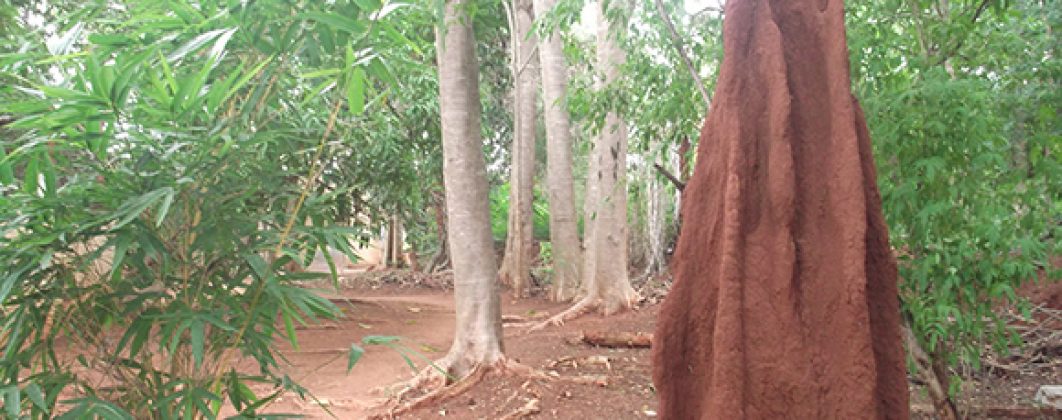

I had visited J. Krishnamurti Foundation India located in a deep forest near Bangalore recently. My friend Mr. Sekhar Rao recommended this place for me to attend their three day course appropriately called “Retreat”. It is a marvellous place full of forest greenery, variety of colourful birds, and wild flowers. In the evening, one has to invariably carry a battery light as it is dark and one has to watch each step. The place is absolutely silent but for the chirping of the birds, wind passing through the well grown trees, and occasional odd jungle sounds.
As part of the Retreat programme, we took a “Nature Walk”, an exercise that takes you on a walk through the forest giving you a chance to appreciate and be part of nature. There are 2 guides who escort the group, one in the front and one in the back, and show us the way through the jungle and protect us from the forest surprises. This was a wonderful experience, particularly for a city dweller like me who is surrounded by concrete jungle all the time.
During one such walk, I saw beautiful red coloured tall and well-built anthills in the campus and they immediately caught my attention. This was a surprise for me! I have never seen such a natural wonder from such close proximity. I touched and felt the anthill. It is very hard and rough. It is a structural marvel built with a fort like design and can be as tall as 10 feet high. This generated a lot of curiosity and I felt like exploring more anthills. I snatched few hours in the morning and started hunting for more anthills in the wild jungle. I saw a variety of anthills and I luckily carried my camera with me so that I could take pictures of these magnificent mud castles built by tiny creatures that we call “ants”. While taking the pictures, I was a bit apprehensive about going too near to the anthill as I heard that snakes generally occupy them and make it their residence once it is deserted by ants. Of course, any snake wouldn’t dare enter an anthill when the colony of ants is in possession of the anthill. I am excited to share the pictures I clicked in this article.



Ants are great architects and builders that nature has ever created. The anthills I saw were built like towering forts ranging from as tall as 8 feet to 12 feet with protective ramparts. There is a central single hole leading to a pipe like passage to the bottom of the pit. The pipe like structure is surrounded by heaps of mud protected by rib like structures on its sides to reinforce the strength to the main structure and to ensure that it does not collapse under adverse conditions. Though there are some other holes on the anthills, I was told that they are designed and built by the ants as false entry holes to mislead and confuse the enemy about the entry point.


Ants build their habitat with supreme vision, great planning, seamless effort, and hard labour. Ants keep on excavating the earth until they find the water bed. Like a royal castle, they have separate sections within the anthill like chambers to eat, sleep, breed, and secure the larvae that is the next generation of ants. By instinct, the anthills are built in un-trodden and secluded areas. The primary purpose for this could be to avoid contact with the human being who is the most destructive creation of nature on the earth.




The basic family unit of ants is called a “colony”. The ants build their life cycle around their colony. A typical ant colony is centred on the egg laying ant or ants with “worker” ants that are sterile female ants. The colony also consists of sexual winged female and male ants whose job is to produce the next generation of ants. Seasonally, the male and female winged sexual ants go out of the nest in swarms for romantic nuptial flights. The males die after the mating along with majority of females and few lucky females which survive come back to the colony to initiate new nests and give birth to the next generation of the ants by laying the larvae.

Basically, an anthill is a pile of clay, sand, or earth, or a combination of these materials that are excavated by the ants in the process of digging. The colony is built and maintained by an army of worker ants. These worker ants carry minute bits of earth and deposit them outside of the exit hole so that the particles do not slide back into the nest. Some variety of ants actually design and architect the anthill to specific shapes to create chambers for their various functions and purpose within the anthill. These robust structures have survived heavy rains, cyclones, sun and other adversities of nature since decades and stand tall and brave for our admiration.


Ants are capable of creating vast empires for themselves. They create super colonies under the ground across countries and continents with underground tunnels. It is quoted that a great super colony was found in the Ishikari coast of Japan consisting of 306 million worker ants and one million queen ants living in 45,000 nests interconnected by underground passages over an area of 2.7 km2 (670 acres). Such super colonies are found in many parts of the globe and these are considered by researchers as parts of a single global mega colony.


In certain countries like Zambia, giant abandoned anthills are located and the natives use the mud to make bricks.
I’m unsure about the binding element that ants use to build such strong hills with tiny particles of earth. I assume that they use their own saliva as a cementing liquid. I touched the forest anthills and they feel so hard. Though this article steers away from talking about antiques, the beauty of these mud castles created by miniscule insects like ants inspired me to write this article and share it with you.
You can subscribe to my blog so that you get updates on my future articles. Use the form below.
[subscribe2]

Copyright © 2021 YK Antiques Home Museum
2 Responses
Hello,
I request your permission to use one of these pictures of anthills in a book – a collection of poems.
Hello Nd Uche ,
You may publish the pictures of your choice in your book. Please acknowledge the source and mention our blog name. Please also send us a copy of your book when published.Wish you success with your book.